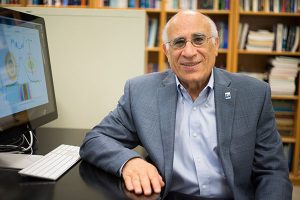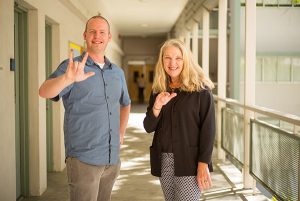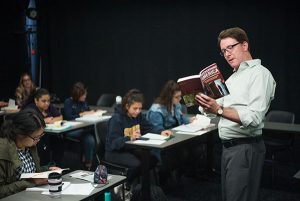
Photo: James Tensuan
Faculty, staff, and student participants of Campus Conversations, held on campus between September 20-22, as part of the strategic planning process.
By Jason McMonagle
San José State University President Mary Papazian set a tone of inspiration at The Strategic Planning Kickoff Event held on September 14. The on-campus event, meant to motivate participation in this year’s strategic planning sessions, gathered more than 300 faculty, staff, administrators, campus leadership, and students. In her opening remarks, President Papazian suggested attendees consider the process to be one of strategic dreaming.
“Whatever we spend our days doing—teaching; managing; coaching; building; communicating; serving—the future of our university depends on our collective openness to dreaming,” President Papazian said then added, “And planning.”
As the President emphasized the shared importance of vision and pragmatism in strategic planning, she reflected the sentiment, “Our Journey,” currently displayed across campus on banners. She said, “This plan will not be my plan…It will be our plan.”
Provost and Senior Vice President of Academic Affairs, Dr. Andy Feinstein, reinforced the President’s remarks and likened the process ahead to the scholar Joseph Campbell’s hero’s journey.
“The hero’s journey offers an inspiring metaphor and insight into what we may encounter over the next weeks, months, and years. As we plan, finalize, and bring ideas into action, we will certainly be tested,” Provost Feinstein said. “New ideas and strategies will be identified, analyzed, and discussed. Some may have great merit while other ideas will be born and exist only as possibilities and then set aside. All hold value.”
The “hero” Provost Feinstein referred to was not singular, but rather the “collective hero” that represents the entire SJSU community. Ariadna Manzo, Associated Student President, emboldened President Papazian’s and Provost Feinstein’s message of teamwork and unity further and motivated attendees—including 25 department chairs, 50 tenured and 15 tenure-track faculty, and 113 MPP’s—when she led the led the room in a Spartan cheer. “Whose University? Our University!”
The kickoff event was followed the next day, September 14, with the Leadership Forum. Approximately 80 participants made up of cabinet members, deans, AVPs, seven staff representatives, three representatives of the Academic Senate, three students, 23 chairs, and three Alumni Association members gathered to bring President Papazian’s message of dreaming and planning to action.
The following week’s Campus Conversations, held from September 20-22, invited SJSU lecturers, tenure-track and tenured faculty, MPP, staff, and students to participate in initial brainstorming sessions. Ann Agee, Librarian and Professor from the School of Information, described the structure of the tenure-track/probationary faculty session she attended, “There were about 35 to 40 faculty members. At our table of eight, we focused on three of the questions we were given.”
One question Professor Agee and her colleagues discussed was: You have the opportunity to talk with a donor. What ideas would you pitch?
“I think it was compelling to talk about the university’s potential with faculty who offered so many different perspectives,” Professor Agee went on to say. “Some of the ideas included having a Research Hub to support faculty involved in large research projects; creating campus-subsidized housing for faculty and staff; promoting research that directly benefited the San José community; and actively promoting interdisciplinary research.”
At the session for tenured faculty on Wednesday, September 20, President of the California Faculty Association and Professor in the College of Social Science, Dr. Preston Rudy, pointed out the general desire to support student achievement that informed his session’s vision of the future.
“A majority of those attending spoke of their enthusiasm and dedication to working with students,” Dr. Rudy said. “Most of us wanted more resources to improve our ability to work with students, including better facilities and support for that work and smaller class sizes to interact more effectively with students.”
In total, 76 MPPs, three chairs/tenured faculty, 14 lecturers, 101 Staff, 21 tenured and 15 tenure-track faculty members attended Campus Conversations. Overwhelmingly, participants credited campus leadership for the invitation and its inclusive gesture and were confident that President Papazian and Provost Feinstein would ensure the strategic planning process was transparent and authentic.
Emily Bruce, Associate Professor in the School of Social Work, who attended one faculty session said, “The other wonderful thing about SJSU, is that it is a University where a member of the faculty can exercise their creativity and have that effort supported and mentored. This also is the case for students; the campus is a place that allows for dreams to come true. We are connected to the community and thus function as an economic engine for this corner of California in ways that are different from the other Universities in the area – and this is a critical role.”
Students also showed their Spartan Pride at the student Campus Conversations over 100 RA’s and 40 other, largely undergraduate, students attended.
The next steps for the strategic planning process include the creation of an online survey, asking faculty, students, and staff six questions designed to replicate the information presented at the Campus Conversation sessions and to recruit up to three GE courses in which to conduct the same strategic planning exercises which occurred in the session. Additionally, the Strategic Planning Steering Committee would especially like further input from the lower division, graduate-level, and commuter students.


